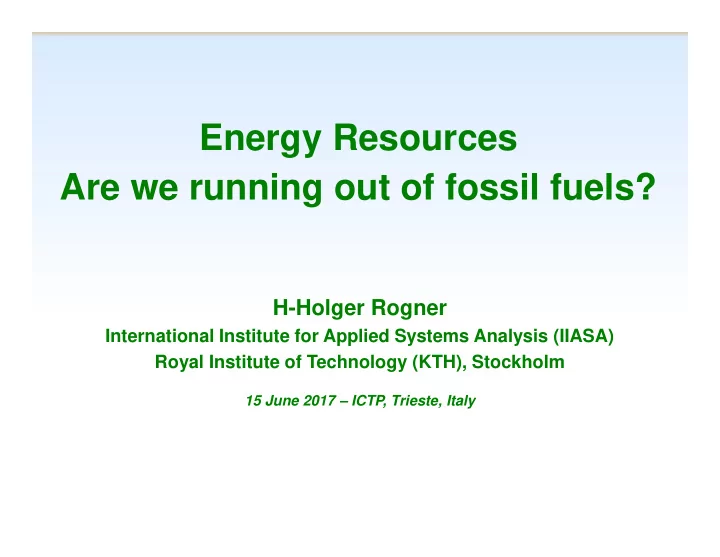

Energy Resources Are we running out of fossil fuels? H-Holger Rogner International Institute for Applied Systems Analysis (IIASA) Royal Institute of Technology (KTH), Stockholm 15 June 2017 – ICTP, Trieste, Italy IAEA
Resources in a nutshell Occurrence of hydrocarbons and fissile materials in the earth’s crust are plentiful There is enough carbon in the ground to fuel global warming Above ground investments unlock below ground resources • Exploration • Production capacity (incl. upgrading) • RD&D in innovative technology Renewable energy flows are gigantic RD&D and investment required for the commercialization of technologies tapping renewable energy flows Resources per se pose no inherent limitation to meeting even rapidly growing future global energy need as long as timely upstream and/or technology investment is forthcoming IAEA
Resources are not – they become 1) The quantity of carbon occurrences in the Earth’s crust is but one consideration = neutral stuff Reserve assessments are the futile effort of estimating the economic portion of an unknown total (M. Adelman) Reserves are “created” by a mutual interdependence of Demand and markets Investment and technology (determine production capacity) RD&D and innovation (pushing frontier) Environmental and social constraints (policy) In many cases the “low-hanging” fruit has already been harvested IAEA 1) E. Zimmermann
Resource classification: The McKelvey Box Identified Reserves Undiscovered Resources Demonstrated Probability range (or) Inferred Measured Indicated Hypothetical Speculative Reserves Economic Increasing degree of economic feasibility Resources Subeconomic Not economic Unconventional and low-grade occurrences Increasing degree of geological assurance IAEA
Comments on the “peak” debates The “peak oil (gas, coal, uranium) debate” is a matter of definitions (boundaries): Conventional versus unconventional occurrences Minimum concentration Technology and innovation Economics (full costs including externalities versus alternatives) and prices Energy security Environment policy, esp. w.r.t. climate change Social preferences (demand) IAEA
Oil reserve discoveries & production 60 140 50 120 40 100 Gbbl per year 80 30 Discovery 60 Production 20 40 10 20 0 0 -20 -10 1930 1940 1950 1960 1970 1980 1990 2000 2010 IAEA
Peak oil or undulating plateau? 120 Undulating plateau 100 Million barrels per day (Mbbl/d) Unconventional oil NGLs 80 60 Conventional oil URR ∑ 3 trillion barrels 40 Conventional oil Conventional oil URR 20 Past production ∑ 2.3 trillion barrels ∑ 1.15 trillion barrels 0 1965 1970 1975 1980 1985 1990 1995 2000 2005 2010 2015 2020 2025 2030 2035 2040 2045 2050 IAEA
Oil based liquid fuel supply potentials and production costs Production cost (2005 $ per bbl) 100 Oil shale 80 Yet to be produced 60 Tar sands and heavy oil Conventional 40 Oil EOR 20 Already produced -8 000 -4 000 0 4 000 8 000 12 000 16 000 20 000 24 000 28 000 32 000 36 000 Resources (EJ) IAEA Adapted from Farrell, 2008.
Oil supply cost curves 60 GEA GEA update/SSP5 Marginal extraction cost ($/GJ) 50 SSP2 40 10 30 8 6 20 4 10 2 0 0 0 5 000 10 000 0 10 000 20 000 30 000 40 000 50 000 IAEA Cumulative oil extraction (EJ)
Shale gas impact on natural gas prices IAEA
Historical production Additional Production 2016 Reserves Resources through 2016 occurrences [Gtoe] [Gt C] [Gtoe] [Gt C] [Gtoe] [Gtoe] [Gtoe] 176 152.28 4.4 3.80 241 147 Conventional oil 16 13.87 0.45 0.39 134 502 > 1 000 Unconventional oil 93 59.0 2.6 168 254 Conventional gas 1.66 5 3.2 0.52 1 603 2 912 >24 000 Unconventional gas 0.33 188 3.7 413 10 390 Coal 202.8 3.95 477 431 11.6 10.1 2 558 14 204 Total FOSSIL IAEA
Fossil reserves, carbon contents & emission budget 7 000 6 000 Non-energy CO2 emissions Unconventional gas 5 000 Gt CO 2 Unconventional oil Conventional gas 4 000 Conventional oil Coal 3 000 ~900 Gt left until 2100 2 000 Global CO 2 emission budget for < 2 o C at 66% probability 1 000 0 Cumulative CO 2 emissions Remaining fossil fuel IAEA Source: Adapted from Rogner (2012) 1750 - 2014 reserves and Bauer et.al (2015)
Fossil resources, carbon contents & emission budget Gt CO 2 60,000 50,000 Unconventional gas 40,000 Unconventional oil Conventional gas 30,000 Conventional oil Coal 20,000 Global CO2 emission budget for < 2 o C at 66% probability 10,000 0 Cummulative Reserves Resources 1750 to 2014 IAEA Source: Adapted from Rogner (2012) and Bauer et.al (2015)
Cumulative CO2 emissions with the goal of keeping global average temperature rise below 2 o C with >50% probability 2 o C with >66% probability As at 2011 1 890 Gt CO 2 1 300 Gt CO 2 1 890 Gt CO 2 1000 As at 2025 1 890 Gt CO 2 553 767 1 890 Gt CO 2 553 467 As at 2030 1 890 Gt CO 2 739 561 1 890 Gt CO 2 739 261 1.5 o C with >50% probability by 2100 As at 2011 1 890 Gt CO 2 550 As at 2025 1 890 Gt CO 2 553 As at 2030 1 890 Gt CO 2 553 Exceedance: 189 GT CO 2 IAEA
Shared Socio-economic Pathways (SSPs) challenges for mitigation SSP 5: SSP 3: Rapid Growth Regional rivalry Socio-economic Taking the highway A rocky road SSP 2: Middle of the Road SSP 1: SSP 4: Sustainability Inequality Taking the green road A road divided Socio-economic challenges for adaptation IAEA
SSPs and Fossil Resources IAEA Source: Bauer et.al, 2015
SSPs and Fossil Resources IAEA Source: Bauer et.al, 2015
Supply cost curves 30 25 Production costs, $/GJ 20 15 2050 supply cost curve 2010 supply cost curve 10 5 0 0 5,000 10,000 15,000 20,000 25,000 30,000 35,000 IAEA EJ
Recommend
More recommend